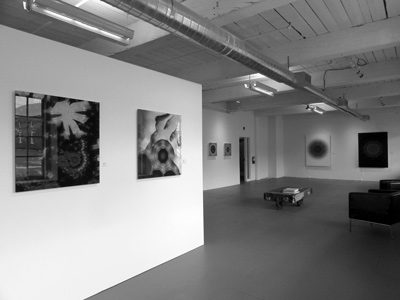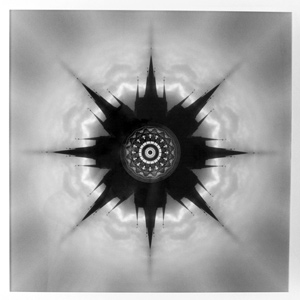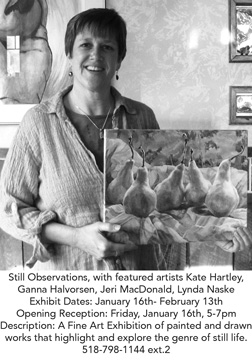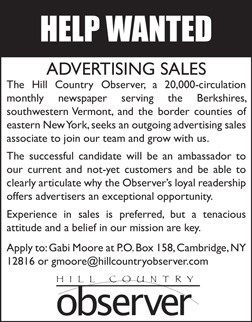Arts and Culture December 2014 - January 2015
Modern landscapes, digitally refracted
Exhibit showcases a pioneer of using computers in visual art
 By JOHN SEVEN
By JOHN SEVEN
Contributing writer
NORTH ADAMS, Mass.
Works by Anne Morgan Spalter, who wrote a widely used textbook on the use of computers in the visual arts, are the focus of a new exhibit at the Independent Art Projects gallery in North Adams.
In Anne Morgan Spalter’s world, physical structures take on spiritual dimensions literally.
The artist uses her own customized computer software to transform the architectural structures of humankind into even more precise constructs. Using mosaic patterns that build on design concepts in Muslim art, her software reveals what the human eye can never see on its own.
Spalter’s work is the focus of a new show, “Modern Renaissance” that opened Nov. 22 and runs through Jan. 4 at the Independent Art Projects gallery, at 1315 Mass MoCA Way in North Adams.
“Modern Renaissance” comprises different bodies of work, including several pieces that use a cathedral in Prague and others that use aerial footage of Manhattan combined with images from the Hieronymus Bosch painting “City of Earthly Delights.”
Each of Spalter’s works uses moving digital imagery alongside still images to create a multi-layered experience of perception.
Spalter, who works from studios in Rhode Island and in Brattleboro, Vt., manipulates the video footage and photos with her custom software a kaleidoscopic effect, but with precision and control that she couldn’t get from commercially available software. It’s that control that takes her work into a realm beyond mere digital trickery.
“There are a number of control points,” Spalter said. “It’s impossible to ever remake it. If you run a kaleidoscopic plug-in on a piece of video, it looks interesting, but it’s not artwork to me. A lot of the work is in finding the parts that look good patterned in that way and moving all the parameters around so that I get the kind of imagery that I want.”
What attracts Spalter to a particular landscape or location is often intangible when she first encounters it. She finds the spirit within that draws her in as a result of her digital handiwork.
“Manhattan is a pretty cool modern landscape, but there’s some sort of internal feeling that I want to also convey, as well as externally what it looked like,” she said. “To me, it’s a lot like painting. It’s just balancing color and proportion and where things are, and then more unique to this computer process, trying to find things that the abstraction lets you see in a different way.”
 From Prague to Manhattan
From Prague to Manhattan
When the human brain sees a photograph, it knows how to process it. But Spalter says her work is comparable to turning that photograph upside down and challenging one’s brain to adjust to the new perception.
“When the linear perspective is gone and you just see this abstract -- pieces moving -- you see the colors and the space in a different way,” she explained. “I try to bring that out so that you understand the color of a scene, the motion of a scene. I can work with the abstract property of it differently than if I was just recreating it as a painting or drawing.”
Unlike art made from more traditional materials, Spalter’s process isn’t well represented in the final product. The technology involved in the process leaves the art’s origins mysterious.
Without brush strokes to view, the one remnant of her process is the video footage she uses, which implies the travel and effort involved in creating the work without spelling it out. The imagery in Prague, for example, was culled from unexpected travel and the unplanned discovery of the cathedral Spalter used. The footage of Manhattan was culled from an intentional small adventure in a chartered helicopter.
“There’s always some sort of weird adventure attached to everything that gets filmed,” Spalter said. “Going up in a helicopter was a crazy experience. We had an amazing pilot who took off the doors for us, and we just went up. There’s no homeland security; it’s all a joke. I had my camera, all this stuff in the helicopter. I was leaning out. You just wear this little seat belt like you’re in a car practically. He went a few hundred feet away from all the major buildings, and we just got incredible footage, so it was really fun. I thought we would have to go all along the rivers, but he took us inside Manhattan, and it was on Thanksgiving Day.”
Shifting stance on digital art
Spalter, whose book “The Computer in the Visual Arts” is widely used as a textbook, was not always a computer enthusiast when it came to creative work. Her artistic training is as a painter.
“When I was in college, I hated the computer,” she said. “And I was a math major also, at Brown, and I refused to use the computer until my last semester of school. I thought it was horrible; artists shouldn’t use it. I was very against it.”
The turnabout began when Spalter was working at a bank in New York City after graduating from Brown University. At her job, she would steal moments to work on her art.
“I discovered I could run art software on my computer at work and work with images,” Spalter said. “If someone came by, I could just click on Excel and have that open. I didn’t really have time to go to a studio and do that. And then I could bring work home on a floppy disc and work with it in my apartment, so it gave me a kind of freedom I didn’t have using traditional materials at that time. But I still really looked down on it.”
When she went to graduate school at the Rhode Island School of Design, she said she promised herself not to give in to the call of digital art again and to devote her time to studio practices and stretching canvas. But she found her brain didn’t completely adjust back from the shift to the computer.
“I started working and did something like make a big red mark that I immediately regretted, and in my mind, I thought, ‘undo,’ because I was so used to using the computer,” she said. “Of course something happened, and I realized that the computer gives you some tools that are amazingly powerful for visual thinking. So I wanted to keep the best of that, but not give up traditional materials, so I did a lot of hybrid things, printmaking, and I tend to go back and forth.”
Spalter said she also never planned to use video in her work. But random use of it convinced her it was the medium for her to achieve what she couldn’t in more traditional forms.
“I felt like it was more like painting to me than oil painting,” Spalter said. “There’s something about it where it seems very similar to me -- composition, color, line. My approach to it, to me, is really similar to painting.”
Spontaneous discoveries
Much of Spalter’s development as an artist has been unplanned. Even the mosaic work came from happenstance.
After an invitation to Dubai, Spalter’s husband promised their host a gift of artwork. Spalter didn’t feel any of her art was appropriate as a gift, so began to pull from a college course in Islamic art to devise new work, taking charcoal and pastel drawings she had done, scanning them in, and creating her first mosaics digitally.
The art went over so well that she wound up on television in Dubai because of it.
At the center of Spalter’s images, more than the technology, are the landscapes that have always fascinated her — untraditional, manmade, even decrepit.
“I’ve always been into landscapes,” she said. “And modern weird landscapes -- not the cows under the tree, but the weird water tower by the side of the highway. And trying to see thing you are almost taught to edit out or not appreciate or look down on, and trying to objectively see them. I find they do resonate with something within me. I’m always taking the photo of the factory or the highway, and not the beautiful trees by the lake or anything.”
Spalter’s digital mosaics are, it seems, just part of a broader forward movement in which she seeks to better express what she has always been moved to capture.
So when a gallery operator visited her and demanded to see all her past work, it revealed more than she expected.
“He said, ‘I don’t care, if you have something from fifth grade, I want to see it,’” she recalled. “I went through and got work from the undergrad and grad school and put it up chronologically in my studio, and it was fascinating because it was all the same.
“It was airplanes, it was weird buildings, being shot from the air or outside my car window, so even though the mediums changed and they didn’t look exactly all the same, the subject matter concerns were all the same. What’s in you is what’s in you. I was surprised.”
“Modern Renaissance” remains on view through Jan. 4 at the Independent Art Projects gallery in North Adams. For details and gallery hours, visit www.IndependentArtProjects.com.
Visit annespalter.com for more information about Anne Morgan Spalter and her work.


